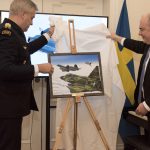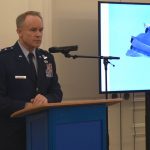At the end of November last year, details of a fascinating cold war mission involving the SR-71 Blackbird came to light, a mission which had remained classified until 2017. The story dates back to the 1980s when Blackbirds made regular clandestine reconnaissance flights over international waters in the Barents Sea and Baltic Sea peering east into nations which then made up the Soviet Union. This is the story of what happened on one of those missions back in the summer of 1987…
Edited from a Story by Capt. Korey Fratini
U.S. Air Forces in Europe and Air Forces Africa Public Affairs
Four retired Swedish Air Force pilots received U.S. Air Medals in Stockholm, Sweden during a ceremony on Nov. 28, 2018. It was long-overdue recognition for their actions on a desperate day 31 years previously. Until last year, the details surrounding their mission had remained classified. During the 1980s, while the Cold War was still in full bloom, the U.S. made regular reconnaissance flights over the Baltic Sea using the superlative SR-71 Blackbird. However, on June 29, 1987, one of these “Baltic Express” missions was dramatically interrupted by an inflight emergency.
Experiencing failure in one of their SR-71’s massive Pratt & Whitney J58 engines, the Blackbird’s aircrew (the now-retired Lt. Cols. Duane Noll and Tom Veltri) slowed their crippled spy-plane down and decreased its altitude to around twenty-five thousand feet near Swedish airspace. Naturally, the Swedish Air Force directed some of their fighters to intercept the stricken SR-71, with two flights of two Saab JA 37 Viggens rising up to meet them. “We were performing an ordinary peace time operation exercise,” recalled retired Maj. Roger Moller, one of the Swedish Air Force Viggen pilots on this day. “Our fighter controller then asked me, ‘Are you able to make an interception and identification of a certain interest.’ I thought immediately it must be an SR-71, otherwise he would have mentioned it. But at that time I didn’t know it was the Blackbird.”
According to the Air Medal citation, once the Swedish pilots intercepted the SR-71, they assessed the emergency situation and decided to render support to the aircraft by defending it from any potential third-party aircraft that might have tried to threaten it. The pilots then accompanied the Blackbird beyond their territorial boundaries to ensure its safe recovery. “I can’t say enough about these gentlemen,” said Veltri, who was at the ceremony. “I am so amazingly grateful for what they did, but also for the opportunity to recognize them in the fashion we are doing. What these guys did is truly monumental.”
Lt.Col.Noll, who was unable to attend the ceremony, did record a message which was played during the medal awards. “Your obvious skills and judgement were definitely demonstrated on that faithful day many years ago. I want to thank you for your actions on that day,” said Noll. “We will never know what would or could have happened, but because of you, there was no international incident. The U.S. Air Force did not lose an irreplaceable aircraft, and two crew members’ lives were saved. Lt. Col. Veltri and I can’t thank you sufficiently for what you prevented. Thank you for being highly skilled and dedicated patriotic fellow aviators.”
U.S. Air Force Maj. Gen. John Williams, Mobilization Assistant to the commander, U.S. Air Forces in Europe and Air Forces Africa, presented the Air Medals to Swedish Air Force Col. Lars-Eric Blad, Majs. Roger Moller and Krister Sjoberg and Lt. Bo Ignell. “That day in 1987 showed us that we can always count on our Swedish partners in times of great peril,” said Williams. “Even when there was both political risk and great physical risk in the form of actual danger, there was no hesitation on your part to preserve the pilots on that day.”
The presentation of Air Medals to the Swedish pilots represented U.S. gratitude and the continued, longstanding partnership with Sweden.



































